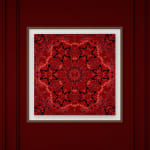Damien Hirst U. K. , 1965
Wu Zetian [H10-1] , 2022
Laminated Giclée print, screen printed with glitter, on aluminium panel
Signed by the artist and numbered on label, on verso
From the series The Empresses, comprising five works
Signed by the artist and numbered on label, on verso
From the series The Empresses, comprising five works
100 x 100 cm
© Damien Hirst, Science Ltd.
In 'Wu Zetian', Damien Hirst masterfully interweaves Chinese symbolism with geometric precision to honour the formidable Tang Dynasty empress. The artwork's focal point features a solitary pair of butterfly wings...
In 'Wu Zetian', Damien Hirst masterfully interweaves Chinese symbolism with geometric precision to honour the formidable Tang Dynasty empress. The artwork's focal point features a solitary pair of butterfly wings encircled by matched pairs, expanding into a hexagonal formation that references Chinese numerological significance—the number six representing harmony across cardinal directions and cosmic planes. This mathematical precision mirrors Wu Zetian's strategic consolidation of power during imperial instability, despite her controversial methods of maintaining authority.
The composition's structural elegance emerges through concentric patterns, with each hexagonal point containing three paired wings, creating a dynamic interplay between symmetry and movement. Brilliant red wings frame the corners, enhancing the work's spatial depth while suggesting expansion beyond its boundaries. This visual strategy creates an illusion of perpetual transformation as if the preserved specimens have regained vitality. The artwork's sophisticated organisation reflects both Wu Zetian's political acumen and the cultural resonance of the hexagon in Chinese tradition, symbolising completeness and equilibrium. This piece is exceptional within Hirst's butterfly series for its harmonious balance between rigid geometric structure and organic fluidity, embodying the tension between order and chaos that characterised Wu Zetian's reign.
...
Damien Hirst's Empresses series is constructed of beautiful images of red butterfly wings intricately arranged with a filigree of red glitter to produce visually intoxicating kaleidoscope-like effects. The prints are named after five exceptionally influential female rulers: Wu Zetian, Nur Jahan, Theodora, Suiko and Taytu Betul. Their characters and stories are enhanced by the dominant red tone of the series, which deals with themes such as life, war, power, anger, love, joy and luck.
Since the beginning of his career, Hirst has interacted with the butterfly, one of his best-known motifs. Inspired by a chance encounter in his studio and the intricate patterns found on Victorian tea trays, The Empresses Hirst develops on the complex compositions he invented in his Kaleidoscope Paintings and Mandalas series.
The Empresses prints are symmetrical, asymmetrical, and spiral patterns of meticulously organised butterflies that nonetheless exude hope and life – the butterflies feel like they are taking flight. This effect is partly aided by the material, laminated Giclée print on aluminium composite, screen printed with glitter, which allows the butterfly wings to be presented in such detail that they appear lifelike. The images of wings inspire awe and are framed by glitter, a fantastically tactile material previously used by Hirst in his paintings. Glitter is loved for its playfulness and joy – a sentiment echoed in the play-on-words of the series title itself, which alludes to female rulers and the Empress Butterfly. Hirst has consistently used butterflies for their associations with freedom, religion, life and death. The Empresses illuminates and sheds light on these themes.
Through this new series, these themes become intertwined with glory, female power and the development of nations, visible through the entrancing twists and turns of these five dazzling and vital visual celebrations.
The composition's structural elegance emerges through concentric patterns, with each hexagonal point containing three paired wings, creating a dynamic interplay between symmetry and movement. Brilliant red wings frame the corners, enhancing the work's spatial depth while suggesting expansion beyond its boundaries. This visual strategy creates an illusion of perpetual transformation as if the preserved specimens have regained vitality. The artwork's sophisticated organisation reflects both Wu Zetian's political acumen and the cultural resonance of the hexagon in Chinese tradition, symbolising completeness and equilibrium. This piece is exceptional within Hirst's butterfly series for its harmonious balance between rigid geometric structure and organic fluidity, embodying the tension between order and chaos that characterised Wu Zetian's reign.
...
Damien Hirst's Empresses series is constructed of beautiful images of red butterfly wings intricately arranged with a filigree of red glitter to produce visually intoxicating kaleidoscope-like effects. The prints are named after five exceptionally influential female rulers: Wu Zetian, Nur Jahan, Theodora, Suiko and Taytu Betul. Their characters and stories are enhanced by the dominant red tone of the series, which deals with themes such as life, war, power, anger, love, joy and luck.
Since the beginning of his career, Hirst has interacted with the butterfly, one of his best-known motifs. Inspired by a chance encounter in his studio and the intricate patterns found on Victorian tea trays, The Empresses Hirst develops on the complex compositions he invented in his Kaleidoscope Paintings and Mandalas series.
The Empresses prints are symmetrical, asymmetrical, and spiral patterns of meticulously organised butterflies that nonetheless exude hope and life – the butterflies feel like they are taking flight. This effect is partly aided by the material, laminated Giclée print on aluminium composite, screen printed with glitter, which allows the butterfly wings to be presented in such detail that they appear lifelike. The images of wings inspire awe and are framed by glitter, a fantastically tactile material previously used by Hirst in his paintings. Glitter is loved for its playfulness and joy – a sentiment echoed in the play-on-words of the series title itself, which alludes to female rulers and the Empress Butterfly. Hirst has consistently used butterflies for their associations with freedom, religion, life and death. The Empresses illuminates and sheds light on these themes.
Through this new series, these themes become intertwined with glory, female power and the development of nations, visible through the entrancing twists and turns of these five dazzling and vital visual celebrations.
![Damien Hirst, Wu Zetian [H10-1] , 2022](https://artlogic-res.cloudinary.com/w_1600,h_1600,c_limit,f_auto,fl_lossy,q_auto/artlogicstorage/dellasposa/images/view/b41e5e33c54320c71ba5810f52f70bfaj/dellasposa-damien-hirst-wu-zetian-h10-1-2022.jpg)
![Damien Hirst, Wu Zetian [H10-1] , 2022](https://artlogic-res.cloudinary.com/w_1600,h_1600,c_limit,f_auto,fl_lossy,q_auto/artlogicstorage/dellasposa/images/view/60821829950c95f5ff37933c5d3a54d5j/dellasposa-damien-hirst-wu-zetian-h10-1-2022.jpg)



